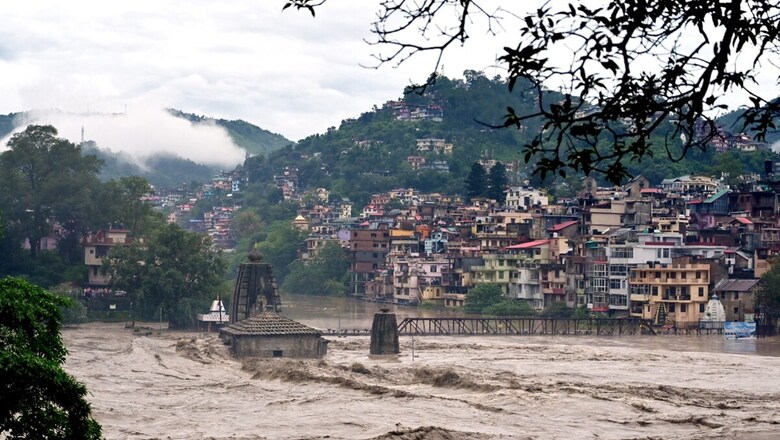
views
Horrendous images of destruction in Uttarakhand, considered the land of gods, and Himachal Pradesh have filled the nation. This is definitely not a good sign. The routine felling of trees for real estate development to encash on the tourism boom and earn lucre has rattled Mother Earth. Landslides have wreaked havoc, so have flash floods and huge cracks that have split houses vertically.
What should we do? The current crisis reminds me of the mass upheavals of the 80s and 90s where farmers and locals of Garhwal Himalayas protested against commercial deforestation. The Chipko Environmental Movement led by Gaura Devi made Indians sit up and see people hugging trees in the hills to stop merchants from felling them.
So, we must ask ourselves if the time has come for another Chipko movement.
Now, the issue is somewhat different from what it was in the 80s and 90s. The immediate cause of this humongous crisis is — arguably — extreme weather. It is not all about felling trees. See what happened in August, the monsoon trough moved north of its normal position to the Himalayan foothills. No one was prepared for it. So, the inevitable happened. There were heavy rains, landslides and flash floods that virtually tore apart the two states. It damaged almost anything and everything. Everything collapsed because of the landslides and flash floods — buildings, bridges, roads, and other infrastructure in the hill states of Himachal Pradesh and Uttarakhand, leaving 238 and 84 dead, respectively.
It was not all over, there was more to come. The trough temporarily moved southward and then again moved to the north of its normal position. Now one needs to understand the weather here.
Every time the trough shifts north, rainfall concentrates over the Himalayan states and Northeast India while the plains remain largely dry. What is surprising is that this is the third time the regions of Himachal Pradesh and Uttarakhand are witnessing weather-driven carnage this season. A careful analysis will show there was another climate change this July, experts called it an interaction between a western disturbance and the resultant trough that caused an extremely heavy rainfall.
So, is it all about climate or something else that is much more serious and merits immediate attention? Experts are telling the government in Delhi that there are larger underlying causes, the most important being the climate crisis and the fact that the Himalayas are relatively young and still geologically active.
Hence, the need of the hour is to immediately stop all unconsidered, unplanned and illegal development. The craze to earn big cash from the travellers who rush to the hills every now and then, choking the systems with their demands for both food and entertainment must also stop. Everyone knows violation becomes normal when tourists visit the hills with their unprecedented demands against very little supplies.
The crisis should not be taken lightly, ostensibly because there is some serious impact of climate change on the temperatures of these two states. And this is also significant with over 1° C warming compared to the long-term average. Newspaper reports said Himachal Pradesh’s average annual mean land surface air temperature during 2022 was 1.2° C warmer than its long-period average for the period 1981-2010.
And then, you have the rain that routinely wreaks havoc. So what happens? Uninterrupted rainfall soaks the topsoil, leading to flash floods and heavy erosion. And then, the structures start collapsing. Experts have time and again highlighted that soil is almost sinking and causing devastation in the geologically sensitive regions of Himachal and Uttarakhand. And continued rainfall is not good news because it saturates the already withered topsoil, triggering small and large landslides and destruction. Why would these landslides happen? Because infrastructure in the hills is not scientifically planned. There are reported violations at every step and rules are flouted as if there is no tomorrow.
Experts have warned the state governments of Himachal Pradesh and Uttarakhand time and again, explaining why there is an urgent need to understand why this is happening with the two states. The experts have said the monsoon trough is very active over the Himalayas. There is often also a confluence or interaction with westerly disturbances which accentuates rainfall. Now, because of this very climate change, some high-altitude regions are recording significant rises in temperatures and hence a rise in the water-vapour holding capacity. Actually, there is a lot of moisture available and when it rains heavily, the top part of the soil becomes environmentally weathered. As a result, very warm temperatures are followed by cold temperatures which means a cycle of thawing and freezing. It eventually degrades the topsoil. Experts have routinely said that there is a lot of anthropogenic activity which can further put these regions at risk such as hill cutting, slope instability, and heavy load, especially in areas where load-bearing capacity is not assessed. So, the locals do not know what to do when calamity strikes.
The need of the hour is to sensitise people about the risks in this terrain in current climatic conditions. Norms need to be followed and no one should look for short-term economic gains which come at the cost of human lives, which is what’s happening in these two states.
One needs to be clear that all kinds of anthropogenic activities cannot be allowed in the Himalayan region. And then, experts need to develop landslide vulnerability maps to identify zones at the highest risk. In short, land use can allow only those structures which are safe. People in the hills need to remember that the Himalayas is a very young mountain range and a lot of subsurface and surface activities are still going on. There is erosion going on due to heavy rainfall events and snowfall. There is exhumation of rocks and plate tectonics. As a result, it is geo-dynamically active due to these ongoing processes. Unstabilised slopes (especially where roads are concerned) and unplanned construction are also to blame.
So what should be done?
It should be made mandatory for construction companies to stabilise slopes, and ensure green cover before leaving a finished project. Secondly, the foundations of buildings and homes have to be deeper. In many recent incidents in Himachal Pradesh and Uttarakhand, the topsoil washed away buildings.
The Char Dham project should have done a top-class environment impact assessment. A lot of landslides took place in the Tanakpur to Pithoragarh stretch. There were 102 sensitive zones and 45 landslides had already taken place in 2019. A geological investigation and environmental impact assessment could have helped avoid the crisis. So what happened? The muck went into the river. When muck goes into rivers, the river level rises and it can cause devastating floods.
I remember how residents of Joshimath, a sacred town in Uttarakhand, were alarmed after noticing fissures in the town’s houses and roadways. It was clear that the town was gradually sinking. As many as 561 establishments in Joshimath reported fractures that appeared after soil subsidence in the Ravigram region of Uttarakhand. In anticipation of a sinkage, many individuals have already evacuated the town.
It is time we retain the sanctity and natural beauty of the Himalayan valley, widely popular as Dev Bhumi or the Land of Gods.
The author is Rajya Sabha MP, Chairman of the Parliamentary Standing Committee on Transport, Tourism & Culture. Views expressed in the above piece are personal and solely that of the author. They do not necessarily reflect News18’s views.




















Comments
0 comment